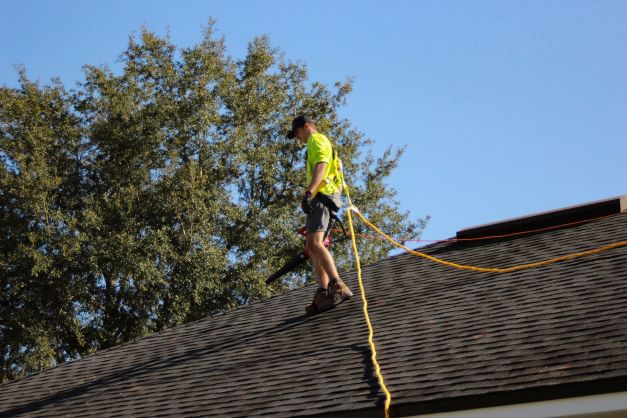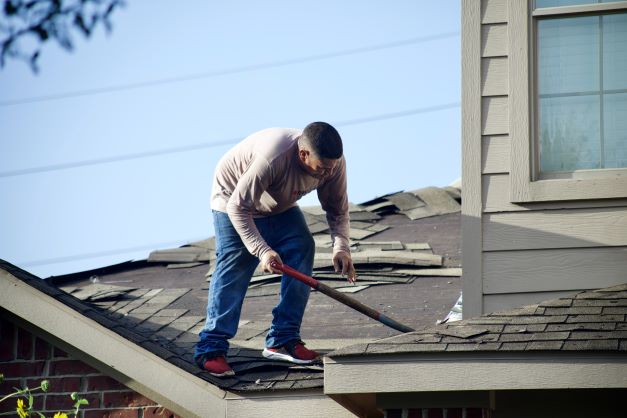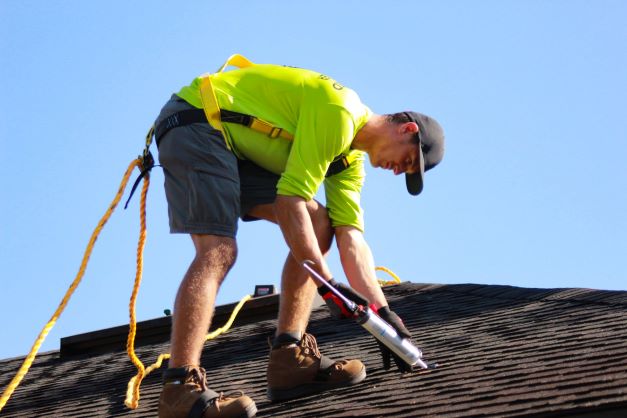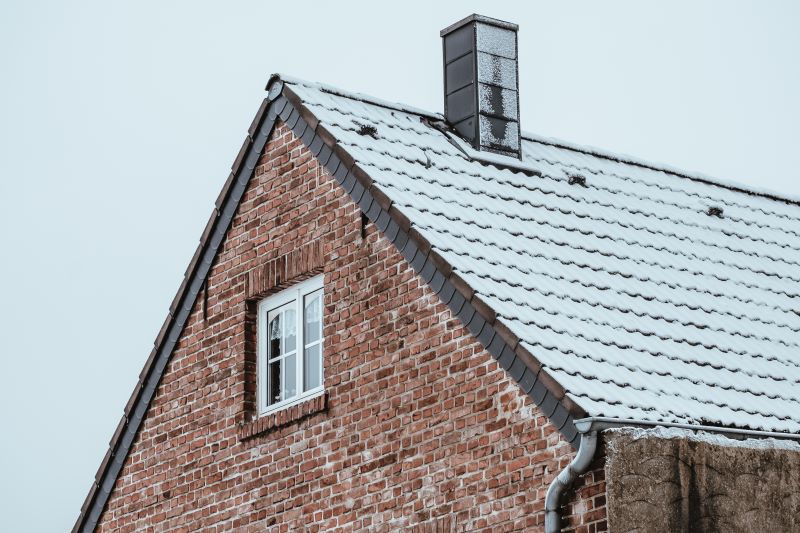Embarking on a roof replacement journey is exciting and essential for the well-being of your home. However, like any significant project, it’s not without its challenges. From unpredictable weather to hidden surprises, there are common hurdles to overcome when replacing a roof.
Fear not! In this guide, we will unveil the ten most common problems you may encounter when you replace a roof. We’ll delve into the solutions and equip you with the knowledge to navigate these obstacles.
So, get ready to conquer the roofing adventure ahead and ensure a successful and stress-free transformation for your beloved abode.

Weather Woes
When you’re replacing a roof, the weather can sometimes cause problems. Imagine if it’s raining or snowing heavily outside. That would make it hard for workers to do their job because they can’t work on a wet roof.
It could also be dangerous if it’s windy because they might get blown off balance. So, what can you do? Well, checking the weather forecast before starting the roof replacement is essential.
If it’s going to rain or snow, it’s better to wait for a clear day. Roofers might have to reschedule the work if the weather isn’t good, but it’s for everyone’s safety and to ensure the roof is done properly.
Sometimes, even if the weather seems fine in the morning, it can change suddenly during the day. If that happens, the workers might have to stop and cover up the unfinished parts of the roof to protect it from getting wet. They’ll wait for the weather to get better before continuing their work.
Remember, weather can be unpredictable, and it’s vital to be patient and flexible during the roof replacement process. The workers’ safety and the roof’s quality are the most important things to consider. So, if you’re replacing a roof, keep an eye on the weather and work with the professionals to ensure everything goes smoothly.
Delays in Material Delivery
Getting all the necessary materials on time can sometimes be a challenge. Delivery delays could be because of factors like bad weather, transportation issues, or even a mistake in the delivery schedule.
If there are delays in material delivery, it may slow down the roofing process. The workers can only start or finish their work with the right supplies. It’s like trying to build a sandcastle without sand or a puzzle without all the pieces. It just doesn’t work!
But don’t worry! The professionals handling the roof replacement will contact the suppliers and keep an eye on the delivery. They’ll do their best to ensure the materials arrive as soon as possible. Sometimes, they might even have backup plans or alternative materials to use temporarily until the right ones come.
Remember, delays in material delivery are not your fault or the workers’ fault. It’s something that can happen unexpectedly. The important thing is to be patient and flexible. The workers will update you and let you know if there are any changes to the schedule.
Accurate Cost Estimates
Replacing a roof can be costly, and it’s vital to have an accurate cost estimate upfront. Before the roof replacement starts, the professionals will give you an estimate of how much the project will cost. They look at factors like the roof size, the materials needed, and the labor involved to come up with the estimate.
But sometimes, the actual cost might be different from the estimate. It’s like when you save money to buy a toy and find out it costs more than you thought because of extra things you need to purchase or taxes you didn’t know about.
For example, professionals might discover that some parts of the roof or the structure underneath must be fixed or replaced. This can add to the cost because it requires extra materials and more work.
But don’t worry! It’s always a good idea to have some extra money saved up, just in case. That way, if there are any unforeseen costs during the roof replacement, you’ll be prepared. Remember, accurate cost estimates are critical because they help you plan and budget for the roof replacement.
Unforeseen Structural Issues

In a roof replacement, sometimes, there might be some unexpected problems hiding underneath. It’s like finding a surprise when you least expect it! These surprises are called “unforeseen structural issues.”
When the old roof is removed, the workers might discover that parts of the house’s structure, like the wood or beams, are damaged or weak. With these, there might be necessary repairs or improvements needed.
It could be because of water leaks, termites, or wear and tear over time. These issues must be fixed before the new roof can be installed.
However, in some cases, these discoveries may even present an opportunity to consider additional home improvements, like integrating renewable energy sources. For example, if you’re already planning on the installation of home solar systems, this could be the perfect time to explore the feasibility of incorporating them during the roof replacement.
By discussing your options with a knowledgeable contractor, you can assess the compatibility of your roof with your desired improvements. They can also help you determine if it would be a wise decision to do so.
Working at Heights

Replacing a roof involves working at heights, which can be dangerous if not done correctly. Roofers need to follow safety protocols, including using harnesses and having proper training. Make sure you hire experienced professionals who prioritize safety.
These professionals wear special gear to protect themselves. They might wear a harness that attaches them to the roof in case they slip or lose their balance. This way, they won’t fall all the way down.
The workers also get training to know how to work safely at heights. It’s like learning the rules of a game or how to use a new gadget. They learn about things like how to move around, how to use ladders and scaffolding, and how to handle tools safely.
So, when you see workers replacing a roof and working at heights, remember that they are trained and have safety gear to protect them. It’s essential to trust that they know how to keep themselves safe. Just enjoy watching the process and know they are doing their best to ensure everything is done right.
Dealing With Old Roof Removal
Removing the old roof is a big task in itself. It can create a lot of debris and can be physically demanding. Professional roofers will handle this part of the job, but it’s important to ensure they have a plan for properly disposing of the old materials.
Sometimes, the old roof can be heavy and hard to lift. That’s why the professionals use special tools and equipment to make the job easier and safer. They might use hammers, pry bars, and even machines to help remove the old roof efficiently.
Interruptions to Daily Life
Roof replacement can be noisy and disruptive, which can affect your daily life. The sound of hammers, drills, and other tools can be quite loud. The workers might also need to move things around outside your house.
They might have to bring in big equipment, like ladders or trucks, to help with the roof replacement. This could temporarily block the driveway or take up some space in your yard.
Sometimes, the workers might need also to access parts of your house, like the attic, to do their job properly. You don’t have to worry as they should always ask for permission and let you know when they need to come inside a room or area to get some things done.
It’s a good idea to inform your neighbors in advance and find ways to minimize disruptions, such as planning the work during a time when you’re less likely to be at home. Just remember that it’s all part of the process. Stay flexible, communicate with the professionals, and soon you’ll have a beautiful new roof without any disruptions to your daily life.
Obtaining Necessary Permits
When replacing a roof, you may need to obtain necessary permits from your local government or building authority. Permits are like official permissions or approvals that ensure the work is done in compliance with safety and building codes.
These permits are necessary they help to ensure that the roof replacement meets certain standards and regulations. They are required to ensure that the construction work is safe and doesn’t pose any risks.
To obtain permits, the contractor or homeowner will need to submit certain documents and information to the relevant authorities. This may include details about the project, such as the scope of work, materials to be used, and structural plans. It’s like filling out forms or providing information for an application.
The authorities will review the submitted documents and plans to ensure they comply with the building codes and regulations. If everything is in order, they will issue the necessary permits. It’s like getting a stamp of approval to proceed with the roof replacement.
The contractor or homeowner is responsible for obtaining the necessary permits. They will coordinate with the authorities, submit the required documents, and pay any associated fees. It’s like taking care of administrative tasks or responsibilities.
Choosing the Right Materials
Selecting the right roofing materials is crucial for the success of your project. The materials used for the roof can affect how it looks and how well it protects your home.
There are various options available, each with its own pros and cons. Consider factors like durability, cost, and appearance when making your decision.
For example, asphalt shingles are popular because they are affordable and come in different colors. Wood shingles give a more natural look but require more maintenance. Metal shingles are durable and can last a long time. And tiles can give a unique and stylish appearance.
You should also think about the climate where you live. It’s like considering the weather conditions or the environment. Some materials are better for rainy areas, while others are more suitable for hot or cold climates. You want to choose materials that can withstand the weather where you live.
Finding a Reliable Contractor
Finding a reliable and trustworthy contractor is essential for a smooth roof replacement process. A reliable contractor is like a trustworthy expert who knows how to do the work properly. They will make sure your new roof is installed correctly and safely.
First, you can ask for recommendations from your family, friends, or neighbors. It’s like asking for suggestions on where to get the best pizza or the best movie to watch. People who had a good experience with a contractor can give you their names.
You can also search online for roofing contractors in your area. It’s like using a search engine to find information about something you’re interested in. Look for contractors who have good reviews and ratings from their customers. This can give you an idea of their reputation and how satisfied people were with their work.
Once you have a list of potential contractors, you can contact them and ask some questions. It’s like interviewing someone for a job to see if they’re a good fit. You can ask about their experience, how long they’ve been in business, and if they have the necessary licenses and insurance to do the work.
It’s also important to ask for references. These are like people who can vouch for the contractor’s work. You can talk to their previous customers and ask them about their experience. This can give you a better idea of the quality of their work and how reliable they are.
Replace a Roof Successfully and Worry-Free
Replacing a roof can come with its fair share of challenges, but with the right preparation, these roofing problems can be easily overcome. By being aware of the potential issues and taking proactive steps to address them, you’ll be well on your way to a successful roof replacement project.
To fully ensure a successful outcome, it is best to consult a knowledgeable contractor. Good luck! Replace a roof today and enjoy a sturdy and beautiful new roof for many years to come!
Be sure to browse the rest of our site for more great content!
